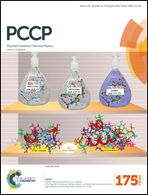Understanding the electron transfer process in ZnO–naphthol azobenzoic acid composites from photophysical characterisation†
Abstract
Semiconductor nanoparticles surface modified with organic molecules capable of visible light absorption and effectively transferring the electrons to the catalytic sites have the potential to be good photocatalysts. ZnO nanoparticles of size ∼3 nm are grafted with two azonaphthols, one conjugated and the other non-conjugated. The photophysical properties of modified ZnO indicate an effective electron transfer from the conjugated azonaphthol to ZnO but not in the case of the non-conjugated molecule. It is also observed from lifetime studies that the conjugated molecule stabilises the defect sites on ZnO nanoparticles. It is possible that excited electrons from the conjugated molecule are transferred to specific defect sites in ZnO. This apparently does not occur in the non-conjugated molecule, bringing to focus the importance of the photophysical characteristics of organic modifiers in designing visible light active photocatalysts.


 Please wait while we load your content...
Please wait while we load your content...